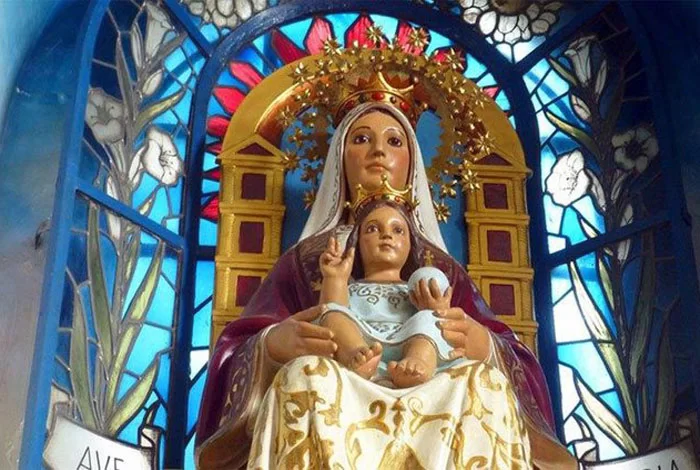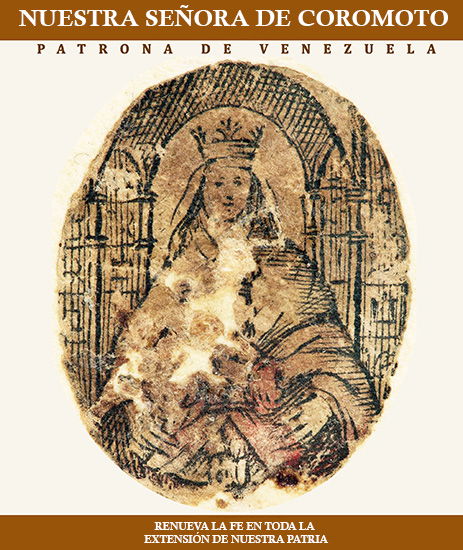Our Lady of Coromoto Patroness of Venezuela

Festivity: celebrated three times a year, February 2nd and September 8th and 11th.
Upon the arrival of the Spaniards to the region of Guanare, around 1591, a group of Indians from the tribe of the Coromotos decided to abandon their land and flee to the Tucupido River, because they wanted nothing to do with the whites or with the religion they brought with them. Fifty years later the Indians, who still have not converted to the Gospel, live in a village not far from the Spanish village; both groups live in harmony, but remain isolated from each other.
In this situation, one morning in the year 1651, the cacique of the Coromotos, together with his wife, was astonished to see an extraordinary vision. In the ravine of the Tucupido River, on the current of the waters, a beautiful lady is looking at them with a kind expression on her face; the small child she is carrying in her arms is also smiling placidly at them. The mysterious lady calls the cacique and orders him: "Come out of the forest together with your people and go to the white people so that they may receive the water on their heads and enter heaven". The cacique, impressed by what he had seen and heard, decided to obey the beautiful lady and went with his tribe to be instructed in the Christian religion.
However, the Indian, accustomed to the freedom of the forests, cannot adapt to the new way of life and, together with his family, returns to his village in the jungle. The lady appears again, this time in the modest hut of the Indian; and although the Virgin appears surrounded by a luminous aura whose rays flood the whole hut with fire, she does not manage to move the cacique who, angry, tries to throw her out and even takes his weapons with the clear intention of threatening the kind lady. Always smiling, the Virgin advances softly towards the cacique and when he angrily extends his hand to catch her, she disappears before his sight. In the clenched fist of the Coromoto Indian was left a small stamp in which the image of the Lady has been imprinted.
The bad example is an obstacle for others to find the truth about Jesus Christ. It has always been like that. How many have been separated from the Church because of the bad example of a priest or someone who is identified with the Church! What a great responsibility we Christians have as ambassadors of Christ! We must at the same time remember that our fidelity to the Church is based on God who never fails. When we see the sin of others, instead of separating ourselves from the Church, we must examine our own behavior which is what we will be judged by. But how difficult is that when one has never known Jesus, as in the case of the Indians, how can they distinguish between bad Catholics and the truth of their religion? It is because of the difficulty of this that the Virgin comes to Venezuela, and with her motherly love she leads the Indians to overcome the obstacle of cultural differences and to receive Jesus through the Church.
The Virgin of Coromoto is a tiny relic measuring 27 millimeters high and 22 millimeters wide. The material of the print could be parchment or "tissue paper"; the Virgin is painted half-length, seated and holding the Child Jesus on her lap. Her appearance is that of being drawn with a fine pen, traced like a portrait in Chinese ink with lines and dots.
The Virgin and Child are facing each other, their crowned heads erect. Two columns joined together by an arch form the back of the throne that supports them. The Virgin covers her shoulders with a crimson mantle with dark purple reflections. A white veil falls symmetrically over her hair, covering it devoutly. The Virgin's robe is straw-colored and the child's robe is white like her veil, and the image is displayed for the veneration of the faithful, protected inside a very rich monstrance.
On October 7, 1944, at the request of the bishops of the nation, Pius XII declared her "Patroness of the Republic of Venezuela" and her canonical coronation was celebrated three centuries after the apparition, on September 11, 1952.
The Cardinal Archbishop of Havana, Manuel Artega y Betancourt, crowned the sacred image of Our Lady of Coromoto on behalf of Pope Pius XII. Venezuelans celebrate their patron saint on three occasions each year, on February 2, September 8 and 11. The National Sanctuary of the Virgin of Coromoto, a meeting place for large pilgrimages, was declared a Basilica by Pope Pius XII on May 24, 1949.


